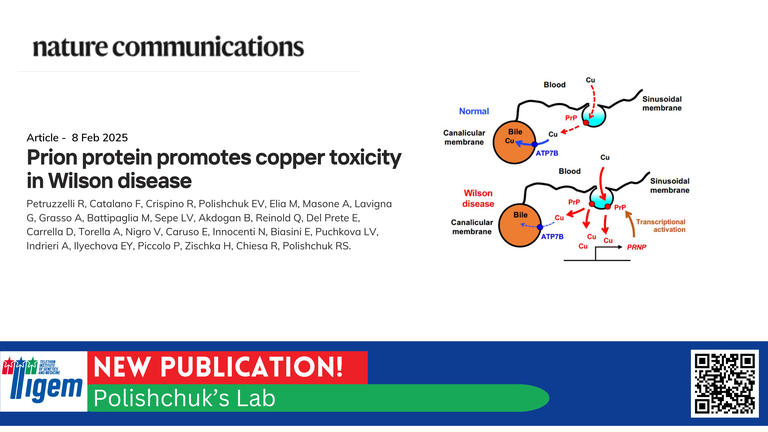Unlocking Copper Toxicity: Prion Protein as a New Therapeutic Target in Wilson Disease

We are excited to share our latest publication in Nature Communications, where Roman Polishchuk and colleagues reveal the role of cellular prion protein (PrP) as a key driver of copper toxicity in Wilson disease (WD). Using genome-wide screening, they identified PrP as a critical factor in exacerbating copper overload in ATP7B-deficient cells. Loss of ATP7B leads to increased PrP expression, which enhances endocytic Cu uptake, driving toxicity in liver cells. Their research demonstrates that PrP suppression significantly reduces copper toxicity, improving cell survival and liver function in WD models. These findings highlight PrP as a novel target for therapeutic intervention in Wilson disease, paving the way for potential new treatments.
Copper Homeostasis and Wilson Disease
Wilson disease (WD) is a genetic disorder of copper metabolism caused by mutations in the ATP7B gene, which encodes a copper-transporting ATPase essential for copper excretion from the liver into bile. Without ATP7B, copper accumulates in hepatocytes, leading to oxidative damage, liver disease, and eventual copper spillover into other organs, particularly the brain. If untreated, WD can result in liver failure, neurological impairment, and death. Although there is no cure, early diagnosis and treatment can prevent disease progression. Current therapies, which focus on reducing copper accumulation and preventing toxicity, have significant limitations and new molecular targets for treatment are needed.
Prion Protein as a Key Mediator of Copper Toxicity in Wilson Disease
Our research reveals that cellular prion protein (PrP) plays a key role in copper (Cu) toxicity in Wilson disease. Using genome-wide screening, we discovered that PrP plays a previously unrecognized role in exacerbating copper overload in ATP7B-deficient cells. In particular, loss of ATP7B results in increased expression of PrP, which enhances endocytic Cu uptake, leading to toxic Cu overload. Suppression of PrP significantly reduces copper toxicity in both cell and animal models of WD.
Therapeutic Potential of PrP Suppression
Our research demonstrates that targeting PrP can effectively mitigate copper toxicity in Wilson disease. Genetic suppression of PrP in Atp7b−/− mice significantly reduces liver damage, while pharmacological inhibition using Zn(II)-BnPyP and SM875 decreases Cu accumulation in ATP7B-KO cells. Additionally, suppressing PrP improves mitochondrial function and prevents fibrosis, two hallmarks of disease progression. These findings suggest that PrP-targeted therapies could serve as a promising new approach to Wilson disease treatment.
Implications and Future Directions
Our findings highlight PrP as a novel target for therapeutic intervention in Wilson disease. Suppressing PrP could improve copper clearance, protect hepatocytes, and mitigate disease progression. Future research will focus on translating these findings into clinical therapies.
